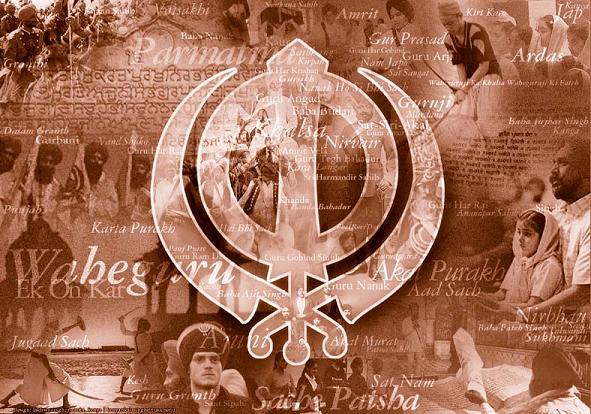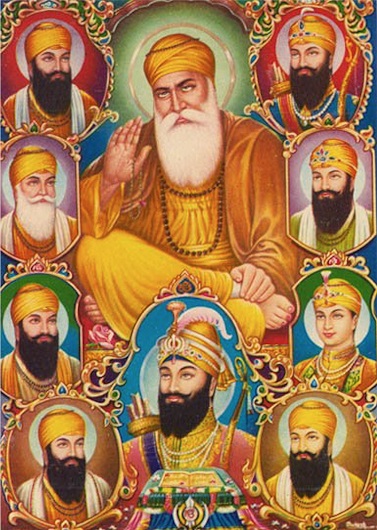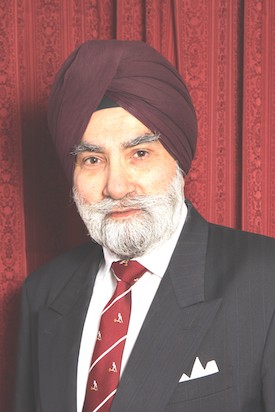Introduction
Sikh ideology looks at the question of war and peace at individual, social, state, and global levels.
Genuine peace is not possible when there is pain and suffering in society. In that sense, Sikh thought agrees that peace is not necessarily the absence of war.
Sikhism is life-affirming and preaches a participative active life of service as a responsible householder. Opt-out systems are rejected.
Sikh concept of “dharam nibhaona” i.e. doing one’s duty as required by different human relationships in different situations and socio-political spheres, is also a benchmark for accountability at every social and political level. In any relationship and situation the concept of dharam (dharma) requires a person to act and behave in a certain way. Ultimately, the discipline of dharam provides stability in human societies; when there is no dharam, there is chaos and conflict.
In early 17th century, Bhai Gurdass wrote that Guru Nanak (1469 –1539), the founder of the Sikh religion “meditated and saw the whole world ablaze” (Vara(n) Bhai Gurdass). The world was at war at every level as a result of human greed, lust, violence, and lack of compassion.
Guru Nanak’s approach to reconciliation between warring factions in religious, social and political spheres was to identify the root causes, and to show the way to a harmonious way of life, which accepted and respected diversity. He brought together the essence of the (apparently diverse) religious ideologies of his time. The Sikh Holy Scripture, Guru Granth Sahib, is the embodiment of that interfaith approach.
Sikh approach
Guru Nanak preached his message of goodwill and peace on earth in the early 16th Century. The Guru knew that it takes much courage, sacrifice and effort to make genuine peace on earth a reality. His was the path of love for God and fellow human being. He said,
“Those who wish to follow the path of love [in the service of God and their fellow beings], should be prepared to make great sacrifices.”
(GGS p. 1412).
So, the succeeding Sikh Gurus spoke out against discrimination and injustice in society, while preaching a responsible family life based on moral values and truthful living. They preached kinship of all creation before One Primal Being.
Sikh thought stresses,
“Where God exists there is no selfishness, where self exists there is no God.”
In this life, there must be balance between material ambition and spiritual well-being.
Sikh approach to war and peace starts at individual level and would agree with the following quotations:
“Men are at war with one another because each man is at war with himself.”
(Francis Meehan)
“War has its roots in human nature.”
and
“War stems from the baser human motivations such as hate, fear, greed and revenge.”
(Albert G Huegli)
Freedom from insecurity and fear is important. High ideals alone are insufficient. It is important to constantly strive for inner freedom from death, attachment and insecurity by meditating on the Name of The Fearless,
“All fear is destroyed through the worship of the Fearless”
(GGS p 293).
“Only that life is good in which the inner battle is fought with determination – through patience (dhiraj) and wisdom”
(Tenth Guru, Guru Gobind Singh, “Krishnavtar”)
Sikh social activism
In Sikhism, involvement in community life is necessary for the creation of a just and peaceful society. It is not for opting out of family and community life. Every person needs to work for peace; especially those who are in positions of power and authority. That is the twin track miri-piri (temporal-spiritual) whole-life path of Guru Nanak.
Security and peace of mind is essential for lasting peace in society. This is only possible when we respect our neighbour’s rights; when we give up selfish obsession with personal gain only; when we enjoy doing service for others, and when we remember that God resides in all. That is the Sikh view, to the extent that selfless service here and now is made a pre-condition for a place in the Lord’s presence in the hereafter (GGS p ).
State and society
At state and administrative level Guru Nanak described the insecure “peace” of his times as follows:-
“Kings are tigers, the courtiers dogs, they harass or awaken those sitting or sleeping as they please.
The tigers inflict wounds with their claws and the curs lick up the blood of the poor subjects.”
(GGS p.1288)
“Greed and sin together as king and minister, and falsehood assuming the role of a chieftain, lust is the deputy called in for daily consultation….”
(GGS p 468)
“Time is the scythe, kings the butchers and righteous living (dharma) has taken flight….”
(GGS p 145)
Such conditions in society, lead to conflict and war.
Peace is only possible when no one inflicts pain on another. Guru Arjan, the Fifth Sikh Guru defined such a regime as “halemi raj”. Being dissatisfied with the prevailing oppressive conditions of an unjust “peace” around him, Guru Arjan “declared” real peace as follows:-
“The Merciful Master has now ordained that no one annoys, oppresses or inflicts pain on, another. All shall abide in peace in a benign regime.”
(GGS p. 74)
That open challenge to cruel regimes, earned the Guru the first martyrdom in Sikh history at the hands of the tyrannical rulers aided by religious zealots of his time.
Bhagat Ravidas, treated as a “low caste” shoe-maker by the oppressive Indian Brahmanic system, also sits amongst the galaxy of the saintly beings in what has been described as the “Parliament of religions”, a Model for interfaith harmony, which is the Sikh Holy Scripture, Guru Granth Sahib. Ravidas further defines peace in a hymn in Guru Granth Sahib:
“Be-gummpura (meaning “town without worry”) is the name of the town
At that place there is no pain or worry
There is no fear of tax of goods there
Neither awe nor terror nor dread
Nor decline (depression) is there
I have now found an excellent abode
My brethren there is everlasting safety there…..”
(GGS p. 345)
In the same hymn, “low caste” Bhagat Ravidas, experiencing the suffocating and restrictive class and caste divisions, and the social discrimination in the society, further stresses the security and freedom which all should enjoy when there is real peace,
“There is no second or third….As they please so they stroll about…
Says Ravi Dass, the emancipated shoe-maker, he who is my fellow citizen, is a (citizen) friend of mine (of that city called Begummpura).”
Religious fanaticism & interfaith harmony
To the zealots, Guru Nanak showed the path to true religion: God is everywhere and in everyone; no religion is superior to another. No matter which religious path one follows, all will miss their final religious objective without truthful conduct and good deeds. The obverse of that is that all religious paths lead to God, because (in the final analysis) all preach truthful conduct and good deeds. Those are the common universal values (dharma) all should be stressing and not the outer ritualism.
Implied in this view is the futility of seeking converts to own religion by condemning others and fighting wars in the name of religion. In returning the world to a more caring society, it is important that religious idiom and allegory is interpreted so that the true spirit of every religion is released. Religions should be seeking converts to peace and contentment.
The third Guru Amardas, prayed to the Creator of all to save the world at war with itself (the “burning” world) and to come to the aid of all those who came to the Lord with a prayer in their hearts, no matter by which religious door they came. (GGS 853)
Guru Nanak’s challenge to unjust regimes
As for rulers, Guru Nanak preached,
“He alone, who is worthy of the throne has the right to sit on the throne.”
(GGS 1039).
This was also his challenge to unjust rule.
Sikhs (students) of the Guru, were set three objectives of “degh, tegh and fateh” for a benign regime . Degh is the cauldron for preparing food and symbolizes open kitchen for all without any discrimination whatsoever; for all have the right to feed themselves. Degh also represents sharing in a society free from greed or personal gain. Tegh is the sword symbolizing justice and the rule of law, and fateh is the ultimate survival of a just society; for, unjust regimes, which have no respect for human life or dignity, are doomed to failure. All have an equal right to the resources of the “great mother earth” (mata dharat mahat).
Sikh martyrdom tradition
Any discussion about war and peace needs to touch on the question of true martyrdom.
Guru Nanak raised his voice in defence of human rights in the service of, and for the love of God, even if it meant sacrificing own life. (GGS 1412). That became the Sikh ideal for the Sikh martyrdom tradition. A martyr, whether as a warrior for a just cause (see below), or when tortured in captivity, has no hatred in his heart. Martyrdom symbolises God love. Sikh martyrdom is an expression of love for the beloved Creator Being while surrendering self in the service of His creation. A martyr is not trying to show that he is stronger than the opponent, but that he is stronger than self in overcoming pain and suffering in God’s Will (raza) while serving God’s creation.
A true martyr in the Sikh religious tradition cannot be a terrorist because he loves the Creator and His creation. Even while resisting evil, he remains a friend of all and enemy of none. (Fifth Guru, Guru Arjan GGS 1299) He fears none and frightens no-one (Ninth Guru, Guru Tegh Bahadhur GGS p 1228)
About invasions
About invasions by empire builders, Guru Nanak had no hesitation in condemning the Mughal Babur who descended on India from the north-west with his marauding hordes. In his poignant composition called “Babur-bani” describing the pillage wreaked by invading armies, wrote Guru Nanak addressing his Sikh, Bhai Lalo,
“With his party of evil has he (Babur) descended from Kabul extracting gifts perforce o’Lalo”
(GGS p 722).
For thus speaking out, the Guru was imprisoned by Babur, but released later; for, even tyrants recognise the fearless who
“say the truth when truth needs to be said” (Guru Nanak GGS p 722).
Armed defence as a last resort
Interpreting Guru Nanak’s founding ideology, the successor Guru persons (ten including Guru Nanak) preached freedom for all humankind from religious persecution, social (caste/class) discrimination and political oppression. Following the path of truthful conduct and righteous action, it is just to strive for universal freedom from oppression and injustice.
Therefore, war is justified in Sikh ideology, but only as a last resort, when all other means have failed, and only in defence of human rights, human dignity, and to seek freedom from tyrannical rule.
The transformation of Sikhs into the Order of the Khalsa (a distinct theo-political order), was not meant simply to continue as an established religion, but as an active medium for change by challenging social inequalities and religio-political oppression; and for winning political power for the ordinary people.
“Strengthening the weak but remaining humble.”
In Sikh ideology,
“Humility is not to be read as a sign of weakness or lack of resolve. On the contrary it is only the strong that can really be humble without being servile or cringing. It is a choice of behavior, made and lived only through deep deliberation.”
(Prof. Nirmal Singh lecture, “Peace Among People”)
Before Guru Nanak, the Bhagats, the saintly beings from diverse religious and social backgrounds, whose teachings are included in Guru Granth Sahib, had already spoken out against unjust regimes and sanctioned defence of human rights through the force of arms as a last resort.
“A true warrior is one who fights for the downtrodden, the weak and the meek.
(Bhagat Kabir GGS p. 1105)
“I honour the saints and punish the wicked. This is my duty as the Lord’s officer.”
(Kabir, GGS p. 969)
The Sikh Gurus repeated the same message:
“Death is a privilege of the brave, if they die for a noble cause”
(Guru Nanak GGS p.579)
Guru Gobind Singh, the Tenth Master, described Guru Nanak’s mission as
“To give security to God loving men, to destroy evil mind and sin, and to ensure victory of good over evil, to create a just society.” and “To promote a righteous regime of dharma, to uplift the saintly, to uproot all evil.”
(Guru Gobind Singh, “Bachittar Natak”)
In the Sikh tradition, battles have been fought for the protection of human rights or to free enslaved people, sometimes even if it meant freeing a single person e.g. when the Sikhs as the Khalsa army, secured the release of a Brahmin’s wife who had been abducted by a local tyrant.
Sikh history records the model regime of Maharaja Ranjit Singh in the first half of the 19th century as follows,
“The ruling class in his reign was composite, and state patronage was extended to all categories of subjects irrespective of their religious affiliation …… Catholicity in relation to non-Sikhs was a common characteristic of the Sikh rulers.”
(Dr J S Grewal “The Sikhs: Ideology, Institutions and Identity” p.91-92)
The Global “village”
It is towards genuine and lasting peace that human regimes should aspire. Labels for regimes such as democracies or dictatorships, or systems such as communism or capitalism have little meaning in Sikh ideology. Unless obstacles to genuine peace discussed above, are removed, then any political system becomes a breeding ground for conflict and terror and threatens peace in the ever shrinking global village. It creates the socio-political environment of dissatisfaction and disaffection leading to conditions of war. Human greed and quest for power, whether by ego-centric individuals or empire building states, lie at the roots of conflict and war.
In the Sikh view, unjust regimes lose their right to rule.
Conclusion
Today we see the results of selfish pursuit of power and wealth. There is much human poverty and suffering while the rich countries get richer. Guru Nanak’s universal message to humankind is highly relevant: to live a life of service, a life of sharing with others, and belief in equality of humankind before One Creator of all.
Peace requires even greater effort than waging wars. So, the Sikh Gurus preached practical religion, making social activism an essential part of religion. The Sikh ideology, of which Guru Granth Sahib is the embodiment, invites all good people of all beliefs to do something about world peace, and to work together for a tolerant and just world order.
© Copyright Gurmukh Singh (U.K.)
E-mail: sewauk2005@yahoo.co.uk
Please acknowledge quotations from this article
Articles may be published subject to prior approval by the author


